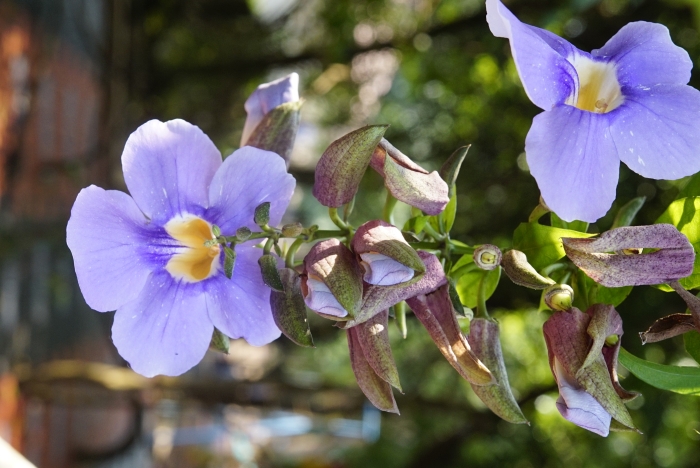Laurel Clockvine
(Thunbergia laurifolia)
Laurel Clockvine (Thunbergia laurifolia)
/
/

Vengolis
CC BY-SA 4.0
Image By:
Vengolis
Recorded By:
Copyright:
CC BY-SA 4.0
Copyright Notice:
Photo by: Vengolis | License Type: CC BY-SA 4.0 | License URL: https://creativecommons.org/licenses/by-sa/4.0 | Uploader: Vengolis | Publisher: Wikimedia Commons | Title: Thunbergia_laurifolia_8723.jpg | Notes: Photo of ''[[Thymus pseudolanuginosus]]'' (woolly thyme) Botanical Garden]], taken July 2005 by [[User:Stan Shebs]] {{GFDL-self}} |

















Estimated Native Range
Summary
Thunbergia laurifolia, commonly known as Laurel Clockvine, is an evergreen or semi-deciduous perennial vine native to the moist deciduous forests and along forest edges in Southeast Asia. It is a fast-growing herbaceous climber that can reach lengths of over 20 feet (6 meters), with a sprawling habit that makes it suitable for covering trellises, fences, and arbors. The vine’s leaves are heart-shaped, and it produces large, showy, sky-blue to lavender flowers with a pale yellow or white throat. These trumpet-shaped flowers are approximately 3 inches (7.6 cm) in diameter and bloom almost continuously throughout the year, particularly from summer to fall, adding a splash of color to tropical gardens.
Laurel Clockvine is valued for its ornamental flowers and its ability to cover unsightly structures quickly. It is often used in tropical and subtropical landscapes for screening and as a ground cover in large areas. In cultivation, it requires well-drained soil, regular watering, and thrives in full sun to partial shade. While it is not particularly drought-tolerant, it can withstand short dry periods. It is not known to have significant disease or pest problems, but it can become invasive outside its native range due to its rapid growth and prolific seed production. Gardeners should be cautious and check local regulations before planting.CC BY-SA 4.0
Laurel Clockvine is valued for its ornamental flowers and its ability to cover unsightly structures quickly. It is often used in tropical and subtropical landscapes for screening and as a ground cover in large areas. In cultivation, it requires well-drained soil, regular watering, and thrives in full sun to partial shade. While it is not particularly drought-tolerant, it can withstand short dry periods. It is not known to have significant disease or pest problems, but it can become invasive outside its native range due to its rapid growth and prolific seed production. Gardeners should be cautious and check local regulations before planting.CC BY-SA 4.0
Plant Description
- Plant Type: Vine
- Height: 15-30 feet
- Width: 0.2-0.3 feet
- Growth Rate: Rapid
- Flower Color: Purple
- Flowering Season: Summer, Fall
- Leaf Retention: Evergreen
Growth Requirements
- Sun: Full Sun, Part Shade
- Water: Medium
- Drainage: Medium, Fast
Common Uses
Bee Garden, Bird Garden, Butterfly Garden, Groundcover, Hummingbird Garden, Low Maintenance, Showy Flowers
Natural Habitat
native to the moist deciduous forests and along forest edges in Southeast Asia
Other Names
Common Names: Blue Trumpet Vine, Babbler’s-Vine, Malayische Thunbergie, 樟葉鄧伯花;月桂藤
Scientific Names: , Thunbergia laurifolia, Thunbergia harrisii, Thunbergia grandiflora var. lauriflora, Thunbergia grandiflora var. laurifolia,
GBIF Accepted Name: Thunbergia laurifolia Lindl.